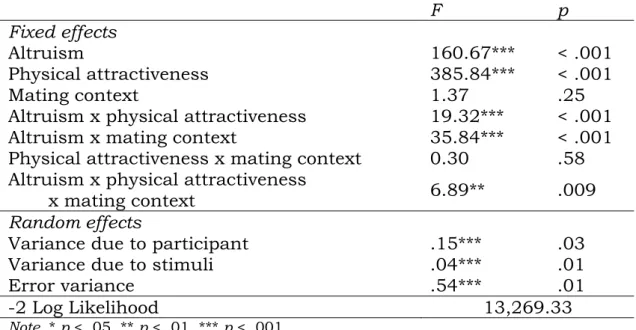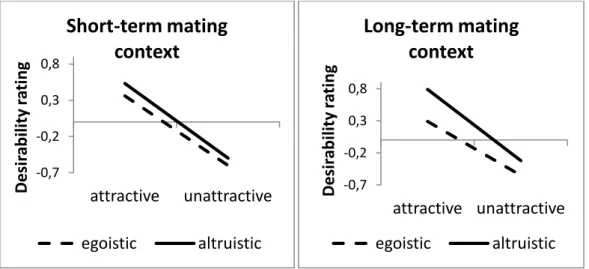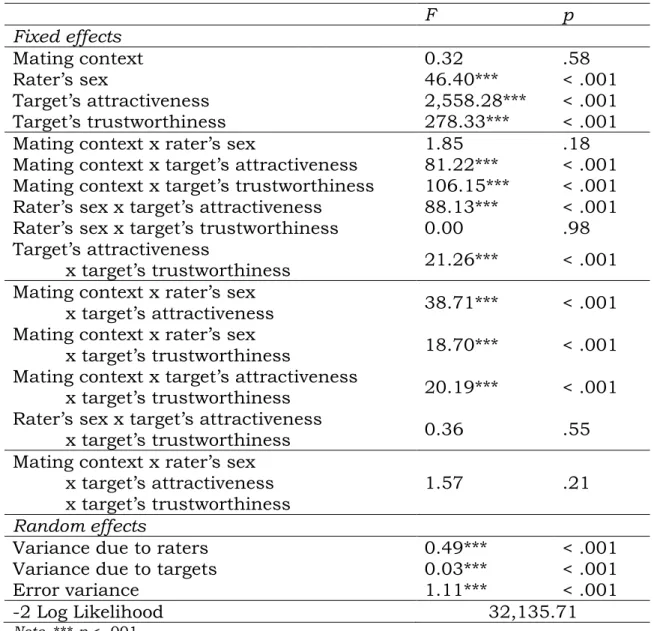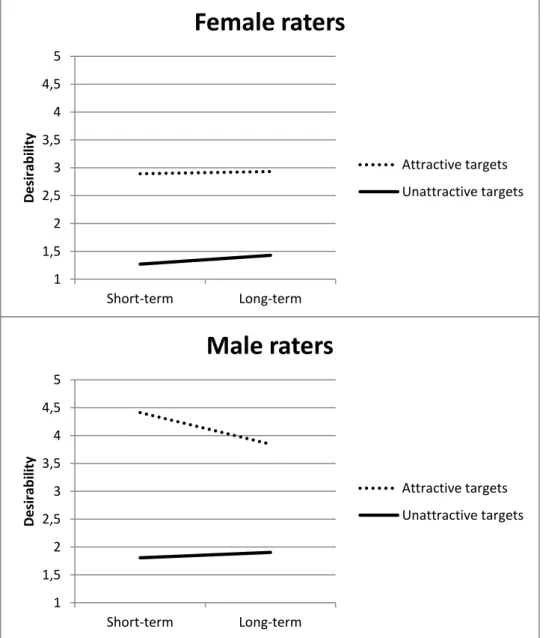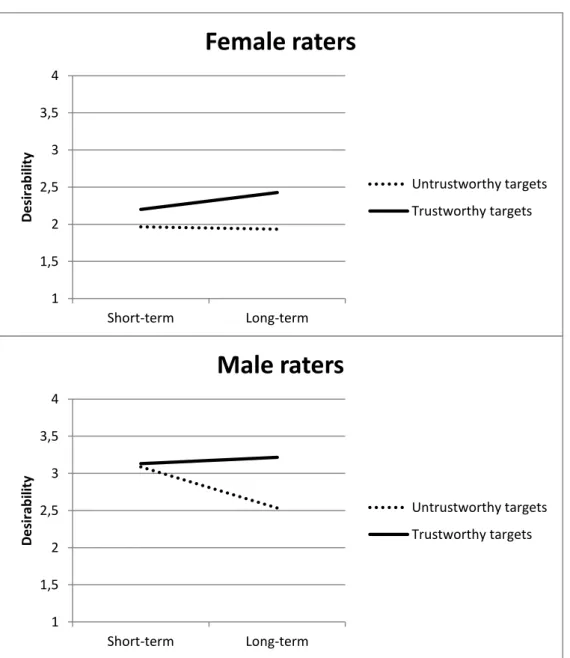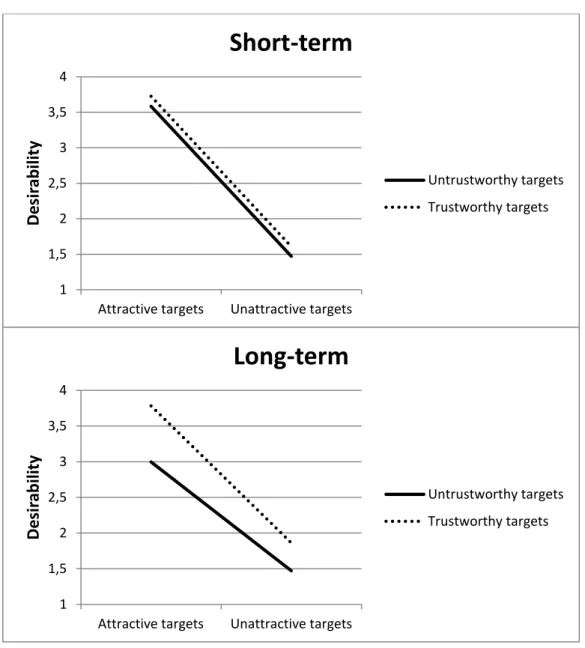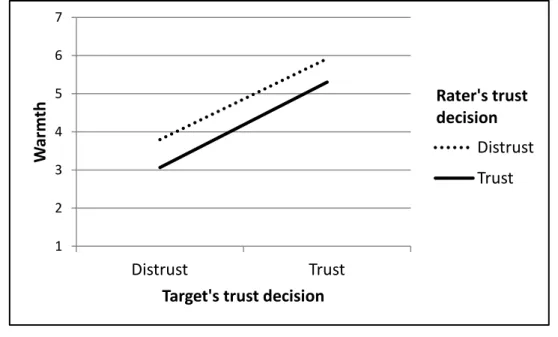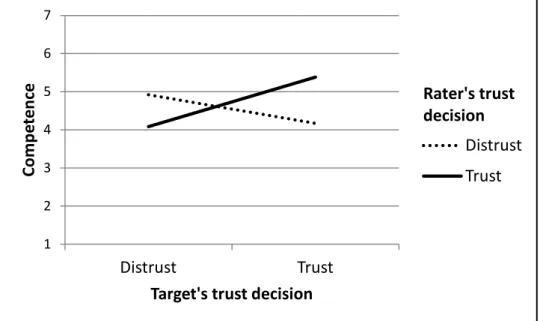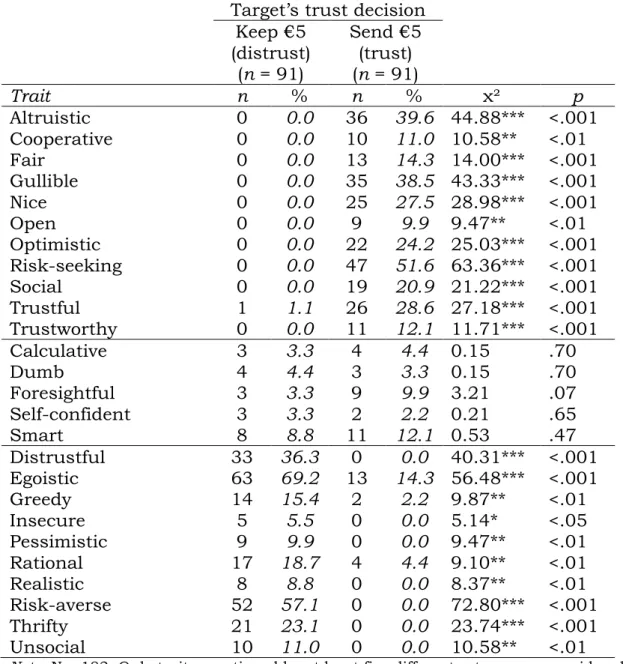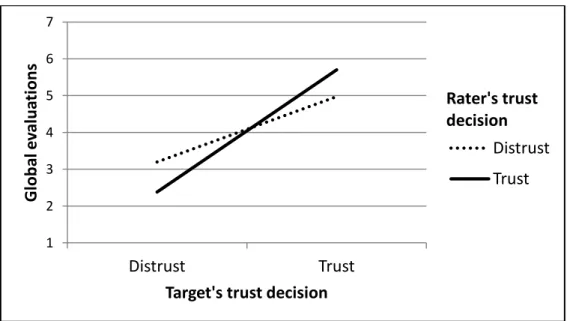Doing good does you good:
Prosocial behavior as a sexual and social signal
Inauguraldissertation zur
Erlangung des Doktorgrades der
Wirtschafts- und Sozialwissenschaftlichen Fakultät der
Universität zu Köln
2013
vorgelegt von
Dipl.-Kfm. Daniel Ehlebracht aus
Stolberg (Rhld.)
Referent: Prof. Dr. Detlef Fetchenhauer Korreferent: Prof. Dr. Erik Hölzl
Tag der Promotion: 15. Oktober 2013
Acknowledgments
As a child, I wanted to be an excavator driver. Thank you, Detlef, for changing that. Since meeting you, I now desire a career as a psy- chologist, for better or for worse.
I never was and probably never will be a psychologist by training.
However, Professor Detlef Fetchenhauer tried his very best to make me think like one. For the effort and invaluable support, continuous inspi- ration, and careful guidance of Prof. Fetchenhauer, I will forever be grateful.
I would like to express sincere gratitude to my coauthors, Dr. Olga Stavrova, Dr. Julia Pradel, and Dr. Thomas Schlösser. Without your support and advice, this thesis would not exist.
Special thanks go to Professor Erik Hölzl, who always provided a sympathetic ear and found the time to encourage me, and whose sincer- ity I value highly.
Furthermore, I would like to thank all current and former col- leagues at the department with whom I had the pleasure of working and spending time. You made me feel at home. I would particularly like to thank Ingrid Kampkötter, who treated me with motherly care, and Dr.
Filippo Cordaro, who turned out to be a soulmate in many respects.
I sincerely thank all of my friends in Stolberg, Cologne, and be- yond, who provided great moral support and without whom my life would be incomplete.
Moreover, I would like to thank Jelena Raehs for bringing so much joy to my life. I hope we will never part because I love you, and because I will probably not be able to edit this paragraph after publication.
Furthermore, I am grateful to my nanny, Hedwig Bartgens, who
was the most perfect substitute for a grandmother that a child could
wish for. She shaped a substantial portion of my moral values, and
tried to convince me quite early that being an excavator driver might
have some downsides.
Finally, I wish to express my deepest gratitude to my family and all the good souls who accompanied me on my journey. In particular, I feel eternally grateful to my mother, Claudia Ehlebracht, and my father, Heinrich Breuer. You are the best parents I could have ever wished for.
My gratitude for the love and support you have given can hardly be put
into words. This thesis is dedicated to you.
Table of Contents
List of Figures ... VIII List of Tables ... IX
1 Introduction ... 1
1.1 Classic evolutionary explanations of human prosociality ... 2
1.2 Biological markets ... 4
1.3 Signaling ... 5
1.4 Overview of the empirical research ... 6
1.5 Coauthors’ contributions ... 9
2 Sexy or kind? Preferences for male physical attractiveness and altruism in females’ short-term and long-term mate choices ...10
2.1 Introduction ... 10
2.1.1 The benefits of strategic pluralism ... 10
2.1.2 Which traits do women desire in short-term and long-term partners? ... 12
2.1.3 The current study ... 15
2.2 Method ... 16
2.2.1 Stimulus material and ratings of physical attractiveness ... 16
2.2.2 Participants and procedure ... 17
2.3 Results... 18
2.4 Discussion ... 22
3 How physical attractiveness and moral virtue shape perceptions of short- and long-term desirability ...28
3.1 Introduction ... 28
3.1.1 Parental investment and sexual strategies theory ... 29
3.1.2 Adaptive problems and preferences in short-term and long-
term mating ... 30
3.1.3 Testing preferences across different mating contexts ... 31
3.1.4 Sex differences in context-dependency ... 33
3.1.5 Interplay between physical attractiveness and moral virtue34 3.1.6 Current research ... 35
3.2 Method ... 36
3.2.1 Pretest of stimulus materials ... 36
3.2.2 Main study ... 37
3.3 Results... 39
3.4 Discussion ... 45
4 On the social perception of trust: warmth, competence, and global evaluations ...50
4.1 Introduction ... 50
4.1.1 Social perception of trust ... 51
4.1.2 Social projection ... 54
4.2 Study 1 ... 55
4.2.1 Method ... 56
4.2.2 Results ... 58
4.2.3 Discussion ... 60
4.3 Study 2 ... 61
4.3.1 Method ... 63
4.3.2 Results ... 66
4.3.3 Discussion ... 70
4.4 General discussion ... 71
5 Integrative discussion ...74
5.1 Key messages ... 74
5.2 Further implications and critical appraisal ... 76
6 Directions for future research ...81
6.1 Traits in context: How and why physical attractiveness and prosocial behavior jointly shape perceptions of desirability ... 81
6.2 Doing good as social signal: How social norms, publicity, and costs of doing good influence the signaling value of social behaviors ... 84
6.3 Good in some respects, bad in every way? Halo effects in person perception ... 86
6.4 Social meta-judgment: Judging how others judge you ... 88
7 Closing words ...91
8 References ...92
9 Curriculum Vitae ... 111
List of Figures
Figure 1: Short-term and long-term desirability ratings
(z-standardized) of physically attractive (one standard deviation above the mean) and physically unattractive (one standard deviation below the mean) male targets who were described either as altruists or as egoists ... 22 Figure 2: Short-term and long-term desirability ratings of physically attractive (one standard deviation above the mean) and physically unattractive (one standard deviation below the mean) targets for
female and male raters ... 42 Figure 3: Short-term and long-term desirability ratings of targets
who were described as either trustworthy or untrustworthy for female and male raters ... 43 Figure 4: Short-term and long-term desirability ratings of physically attractive (one standard deviation above the mean) and physically unattractive (one standard deviation below the mean) targets who
were described either as trustworthy or untrustworthy ... 45
Figure 5: Ratings of warmth as a function of the target’s stated and
the rater’s hypothetical trust decisions ... 59
Figure 6: Ratings of competence as a function of the target’s stated
and the rater’s hypothetical trust decisions ... 60
Figure 7: Global evaluations as a function of the target’s stated and
the rater’s hypothetical trust decisions ... 69
List of Tables
Table 1: Mixed regression model with desirability ratings as the
dependent variable ... 20 Table 2: Mixed regression model with desirability ratings as the
dependent variable ... 40
Table 3: Inferred traits split by the target’s trust decision ... 67
1 Introduction
“No man is an island, entire of itself;
every man is a piece of the continent, a part of the main”
John Donne
English clergyman and poet (1572 - 1631)
Since the dawn of evolutionary theory (Darwin, 1859, 1871), schol- ars have been applying the laws of natural selection to research on physiological structures. Since this time, it has been suggested that the defining features of a species, such as a turtle’s resilient shell or a pi- geon’s inner compass, result from undirected evolution rather than purposeful creation. However, many scholars have been reluctant to apply the laws of natural selection to humans, particularly human minds. Thus, the study of the human mind long remained within the domain of psychologists, philosophers, and theologians.
However, since the second half of the 20
thcentury, with the advent of ethology (Lorenz, 1965; Tinbergen, 1951), evolutionary theory has slowly been conquering the realm of psychology, and scholars now con- sider that animal and human traits, emotions, cognitions, and behav- iors result from variation, inheritance, and selection (Brown, 1991; Har- low, 1971; Seligman, & Hager, 1972; Wilson, 1975). This recent consid- eration also implies a shift of perspective from proximate explanations (how, i.e., the causal mechanisms) to ultimate explanations (why, i.e., the fitness consequences) of behavior (Tinbergen, 1963).
Many traits, emotions, cognitions, and behaviors have been con- sistently explained and predicted using the laws of natural selection.
However, there is one last secure stronghold, withstanding many evolu- tionary explanations: human prosociality (West, El Mouden, & Gardner, 2011). Charles Darwin was astonished by frequent display of virtue and bravery in humans, and he struggled to fathom morality in terms of natural selection (Darwin, 1871). Why do people perform good deeds?
Why do people take costs and run risks to bestow benefits upon others?
In the following sections, I will provide a short account of two clas- sic evolutionary explanations of human prosociality, altruism, and co- operation, particularly with regard to the shortcomings concerning the explanatory power of these principles for many real-life instances of human prosociality. As an extension and alternative, I will introduce the idea of biological markets (Noë, & Hammerstein, 1994, 1995) and sug- gest how prosociality can be explained as a result of signaling mecha- nisms. I will conclude this chapter with a discussion of some theoretical considerations underlying my research and provide an overview of the following empirical work.
1.1 Classic evolutionary explanations of human prosociality
In this chapter, I will use the terms altruism, cooperation, and prosociality interchangeably to describe the costly behaviors of a send- er, which grant immediate benefits to a receiver. West, Griffin, and Gardner (2007, p. 662) define altruism as “a behavior that is costly to the actor and beneficial to the recipient” and further clarify that “cost and benefit are defined on the basis of the lifetime direct fitness conse- quences of a behavior”. Direct fitness is defined as “the component of fitness gained from producing offspring; [i.e.,] the component of person- al fitness due to one’s own behavior” (p. 662).
Natural selection operates on differences in reproductive fitness (i.e., relative reproductive success). Over the course of time, selection favors traits that increase fitness and eliminates traits that decrease fitness. Altruistic behavior reduces the fitness of the sender and in- creases the fitness of the receiver; therefore, this behavior should be ruled out by natural selection (Trivers, 1971).
One explanation for the evolution of altruism is Hamilton’s (1964)
theory of inclusive fitness. Inclusive fitness transcends Darwin’s (1859)
concept of classical fitness by accounting for the effect of an individual’s
actions not only on personal reproductive success, but also on the re-
productive success of genetic relatives. Because genetic relatives share
copies of genes (with the probability of gene sharing determined by the
degree of genetic relatedness), helping one’s kin might increase one’s inclusive fitness. The closer one is related to the recipient, the more one should be inclined to help. While classical fitness considers the perspec- tive of a single individual, inclusive fitness reflects the perspective of a single gene (Dawkins, 1989; Hamilton, 1964; Williams, 1966). From the perspective of a single gene, it does not matter whether copies reside within one organism or another, as long as these genes are successfully passed on to future generations. Although inclusive fitness theory can be considered the single most important recent addition to the theory of natural selection (Buss, 2012), the explanatory power of this principle, regarding human altruism, is limited to a comparatively narrow range of helping behaviors, namely help among genetic relatives. However, in real-life, altruism is not confined to help among kin. People frequently bear costs to help individuals who are not relatives.
Altruistic behavior among non-kin can be explained by the theory of reciprocal altruism (Trivers, 1971). Reciprocal altruism occurs when individuals cooperate for mutual benefit (Cosmides, & Tooby, 1992), i.e., when benefits bestowed upon non-relatives are reciprocated in the fu- ture. The beauty of reciprocal altruism is that individuals help in times of abundance and receive aid in times of need. Thus, the benefits ex- ceed the respective costs of helping (Trivers, 1971). However, reciprocal altruism only occurs within social relationships that allow for repeated interactions (Axelrod, & Hamilton, 1981). Similarly, according to the principle of reciprocal altruism, those whom we help must be both able and willing to reciprocate in the future. Human prosocial behavior fre- quently violates these premises. For example, people often give change to beggars who they rarely encounter again and who they do not expect to reciprocate anything at any given time.
How can evolutionary theories explain prosocial behavior that vio-
lates the premises of the inclusive fitness theory and the theory of recip-
rocal altruism? The basic idea underlying this thesis is that good deeds
might evoke future benefits by signaling the qualities of an individual to
third parties, ultimately increasing his or her value as a partner in a biological market.
1.2 Biological markets
Humans populate biological markets. In a biological market, indi- viduals compete for access to relationships with valuable partners who provide benefits relevant to reproductive fitness (Barclay, 2013; Noë, &
Hammerstein, 1994, 1995). A particular subset of a biological market is the mating market, where men compete for sexual access to desirable women, and women compete for access to desirable men. The most de- sirable women mate with the most desirable men and successfully re- produce, whereas less desirable individuals must stick with other less desirable individuals or perish. However, mating is not the only domain governed by the laws of biological markets. In a biological market in the broadest sense, many “commodities” are traded and many “currencies”
exist, e.g., protection, sexual access, and coalitional aid. In other words, whenever individuals are free to choose whom to interact with and whom to shun, and whenever one’s own reproductive success is contin- gent upon the actions of others, biological markets emerge (Barclay, 2013). Individuals differ in traits that render them better or worse part- ners and thus determine their market value. To attract good partners, individuals must be considered good partners. However, this rationale does not imply that biological markets unite individuals possessing the same traits or looking for the same things. Rather, this idea implies that biological markets bring together individuals whose aggregated traits represent the same market value to each other (Barclay, 2013). A simple example from the mating market is that a very affluent but physically hideous man might succeed in attracting a very beautiful but desper- ately poor woman, and vice versa. As for any market, biological markets adhere to the laws of supply and demand.
A forerunner to the idea of biological markets is indirect reciprocity
theory (Alexander, 1987; Nowak, & Sigmund, 1998, 2005). According to
this theory, altruistic acts demonstrate the propensity of an individual
for doing good and contribute to the reputation of the focal individual as a benefactor. Third parties consider this reputation when identifying cooperation partners (Barclay, 2004). However, the concept of indirect reciprocity is much narrower than the concept of biological markets, as this principle implicitly states that cooperation will be rewarded with the future cooperation of third parties. In other words, cooperation is the only commodity in the model of indirect reciprocity, whereas in the model of biological markets, anything relevant to reproductive success can be a commodity, and the willingness and ability of an individual to provide these commodities determines their value as a partner (Barclay, 2013).
1.3 Signaling
I argue that the propensity of an individual to perform good deeds is a valuable asset in a biological market because it might increase the market value of the individual as both an intimate and cooperative partner.
However, before empirically extending this argument in Chapters 2 to 4, one must first consider that individuals must identify partners possessing a propensity to perform good deeds. Signaling might be a solution to this problem.
Just as the lavish and luminous plumage of the peacock signals superior health to peahens, good deeds might signal some underlying qualities of the individual, even (and arguably particularly) if these good deeds are directed towards third parties, i.e., if the observer of the sig- nal does not directly benefit from the good deed. This idea has been formalized as the handicap principle or costly signaling (Gintis, Smith, &
Bowles, 2001; Lotem, Fishman, & Stone, 2003; Zahavi, 1975, 1977
1995; Zahavi, & Zahavi, 1996). Beyond signaling a good character to
third parties (e.g., Barclay, 2004), altruistic and cooperative acts are
assumed to reflect a wide range of underlying qualities, such as re-
source-holding potential, low mutation-load and even general intelli-
gence (Miller, 2000, 2007; Millet, & Dewitte, 2007). Advocates of the
costly signaling theory suggest that a signal must be particularly costly and hard-to-fake to serve as an honest signal for the underlying trait, i.e., that only individuals possessing the trait can “afford” the signal (e.g., Lotem et al., 2003; Zahavi, 1977; Zahavi, & Zahavi, 1996).
However, if the object of study is limited to signals of morality, I ar- gue that, in case of doubt, even small and minor deeds can be regarded as telltale signs of good or bad character, thereby affecting the market value of an individual. Even if selfish people might sometimes strategi- cally fake signals of good character by doing good, the definition of self- ishness requires that these instances will only occasionally occur. After all, if a selfish individual behaved selfless at all times (even if only for the purpose of falsely signaling selflessness), the individual could no longer be considered selfish. In short, as long as there is a higher prob- ability of observing a good person performing a good deed than observ- ing a bad person performing a good deed, these signals will affect trait inferences, particularly if other sources of acquiring information are limited. Indeed, as classic psychological research of the fundamental attribution error shows, humans attribute the isolated actions of others to the character of the individual rather than situational factors (Ross, 1977). Heuristics such as these would likely not have evolved if they did not often lead to valid inferences (Gigerenzer, & Todd, 1999; Harvey, Town, & Yarkin, 1981).
1.4 Overview of the empirical research
Together with Olga Stavrova, Julia Pradel, Thomas Schlösser, and
Detlef Fetchenhauer, I examined the effects of isolated acts of prosocial
behavior as signals of good character across four studies. Two determi-
nants of the market value of an individual were considered: desirability
as a mate (Chapter 2 and Chapter 3) and desirability as a cooperative
partner (Chapter 4). Specifically, we explored the conditions under
which isolated prosocial acts lead to considerable gains in the desirabil-
ity as a mate or cooperative partner and the conditions under which
such acts fail to have an effect.
On the one hand, these conditions might reflect the structure of demand within specific subsets of biological markets (Chapters 2 and 3). According to sexual strategies theory (Buss, & Schmitt, 1993) and the theory of strategic pluralism (Gangestad, & Simpson, 2000), prosociality signals might differentially impact the market value of an individual as a short-term partner as compared to the market value as a long-term partner.
On the other hand, there might be ambiguity due to different inter- pretations regarding the traits underlying specific signals (Chapter 4).
Depending on situational circumstances and the person of the observer, the same act might be construed in terms of different traits, e.g., moral- ity and competence, leading to different representations of the market value of an individual as a cooperative partner.
Doing good has many facets. In the present research, however, we concentrated on three classes of prosocial behavior: altruism (Chapter 2), trustworthiness (Chapter 3), and trust (Chapter 4).
In Chapter 2, we explored how signals of altruism shape percep- tions of desirability in the short-term and long-term mate choices of fe- males. According to the theory of strategic pluralism (Gangestad, &
Simpson, 2000), most women possess distinct mate preferences allow-
ing them to identify short-term partners with good genes and long-term
partners with adequate partner or parenting characteristics. We pre-
sented video clips of male targets possessing various levels of physical
attractiveness and provided counterbalanced information on the behav-
ior of the targets in a one-shot dictator game. Female raters evaluated
the targets with regard to the desirability as either short-term sexual or
long-term romantic partners. Signals of altruism were more relevant for
long-term rather than in short-term mate choices, whereas preferences
for physical attractiveness were equally pronounced in both contexts. In
addition, we observed that in long-term mating, displays of altruism
had a larger effect on the desirability of physically attractive rather than
unattractive targets.
Chapter 3 extended the scope of our first study by accounting for both female and male preferences and further substantiating the inter- play between signals of morality and physical attractiveness. Based on sexual strategies theory (Buss, & Schmitt, 1993) and a cognitive per- spective of preferential mate choice (Miller, & Todd, 1998), we experi- mentally investigated the ways physical attractiveness and signals of moral virtue jointly shape perceptions of desirability in the long- and short-term mate choices of females and males. Silent video clips of tar- get actors differing in physical attractiveness were presented to raters of the opposite sex who were provided with counterbalanced information regarding the decision of each target as a trustee in a one-shot binary trust game (previously validated as a suitable signal of moral virtue).
The raters judged the desirability of the targets as either short-term sexual or long-term romantic partners. Physical attractiveness had a larger influence on desirability ratings in the short-term context, where- as moral virtue was more important in the long-term context. The pref- erences of males were more context-dependent, shifting more strongly towards physical attractiveness in the short-term context and moral vir- tue in the long-term context than the preferences of females. In the long-term context, physical attractiveness and moral virtue were mutu- ally reinforced regarding their effects on perceptions of desirability.
In Chapter 4, we examined the influence of trustful behavior on the
value of individuals as cooperation partners. In general, people prefer
cooperation partners that possess both the willingness and the ability to
cooperate (Fiske, Cuddy, & Glick, 2007). However, trust is a double-
edged sword; depending on the situation, trustful behavior might be
perceived as self-interested or other-regarding, smart or gullible. Across
two studies, noninvolved observers inferred personality traits from
trustful versus distrustful behaviors in the context of a one-shot binary
trust game. Considering the effects of social projection and consequen-
tialism, we observed that trustful behavior was almost universally per-
ceived more favorably than distrustful behavior with regard to funda-
mental dimensions of social judgment, namely warmth and competence,
and with regard to overall evaluations of personality. These findings support the notion that displays of trust might serve as social signals, demonstrating the qualities of an individual as a cooperative partner.
A short integrative discussion of the empirical research presented in Chapters 2 to 4 is presented in Chapter 5, and future research is outlined in Chapter 6.
1.5 Coauthors’ contributions
Chapter 2 is based on a manuscript submitted to the British Jour- nal of Social Psychology together with Julia Pradel, Olga Stavrova, and Detlef Fetchenhauer. Julia Pradel designed and conducted the study.
Olga Stavrova assisted with the analysis and interpretation of the exper- imental data and the preparation of the manuscript, particularly re- garding the results section. Detlef Fetchenhauer provided advice on the experimental design and preparation of the manuscript.
Chapter 3 is based on a manuscript submitted to Personal Rela- tionships together with Olga Stavrova and Detlef Fetchenhauer. Olga Stavrova assisted in the analysis and interpretation of the experimental data and provided feedback on various drafts of the manuscript. Detlef Fetchenhauer provided advice regarding the design of the study and the preparation of the manuscript.
Chapter 4 is based on a manuscript prepared for submission to the
European Journal of Social Psychology together with Thomas Schlösser,
Olga Stavrova, and Detlef Fetchenhauer. Thomas Schlösser provided
advice concerning the design of both studies. Olga Stavrova assisted
with the analysis of the data and interpretation of the results. Detlef
Fetchenhauer provided advice on the experimental design and prepara-
tion of the manuscript.
2 Sexy or kind? Preferences for male physical attractiveness and altruism in females’ short-term and long-term mate choices 2.1 Introduction
Which traits do women seek in a man when they are looking for
“Mr. Right”? In fairytales, “Mr. Right” is usually both handsome and vir- tuous, like Prince Phillip in “Sleeping Beauty”, who overcame a forest of thorns and defeated the wicked fairy to awake beautiful Aurora with a kiss. Unfortunately, men like Prince Phillip are few and far between.
Yet, in real life, living happily ever after is not the only type of possible relationship. Thus, women might find a man as kind (but most likely not as handsome) as Price Phillip for a committed long-term relation- ship, while still occasionally having sex with a man as handsome (but most likely not as kind) as Prince Phillip.
In the present study, we explore whether female preferences to- ward physical attractiveness and altruism are subject to strategic plu- ralism (Gangestad, & Simpson, 2000), i.e., whether female preferences for physical attractiveness are more relevant in short-term than in long- term mate choices, whereas preferences for altruism are more pro- nounced in long-term than in short-term mate choices. However, why may such a shift in preferences occur?
2.1.1 The benefits of strategic pluralism
The theory of parental investment (Trivers, 1972) postulates that women invest more time and effort into their offspring and should thus be choosier than men in regard to mate selection. Because women are more limited than men in their hypothetical maximum number of off- spring, they typically cannot increase their reproductive success by hav- ing a large number of mates. Hence, women should place a high value on the quality (rather than the quantity) of their potential mates, both in terms of genetic endowment and in terms of qualities as a good partner or loving parent for future offspring. Still, a popular notion says that
“you can’t always get what you want”, and very few women will be able
to attract a partner who is endowed with both good genes and good
partner or parenting characteristics. According to the theory of strategic
pluralism (Gangestad, & Simpson, 2000), women may consider obtain-
ing these different qualities from different partners, i.e., looking for good
genes in short-term sexual partners and looking for good parenting or
partner characteristics in long-term mates. On the other hand, accord-
ing to Gangestad and Simpson (2000), men should react to female pref-
erences by specializing in one particular mating strategy: those en-
dowed with superior genes (and thus appearance) could benefit from
specializing in short-term mating. It has been shown that facial and
bodily attractiveness in males is correlated with an increased number of
short-term, but not long-term, sexual partners and with an earlier onset
of sexual activity (Rhodes, Simmons, & Peters, 2005). Furthermore,
Simpson and Gangestad (1991) showed that unrestricted sociosexuality
in men is correlated negatively with markers of relationship quality,
such as commitment to the current partner, investment in the ongoing
relationship and love for and psychological and emotional dependency
on the current partner. On the other hand, according to Gangestad and
Simpson (2000), men who cannot signal their genetic qualities through
physical attractiveness could compensate for this weakness by demon-
strating their qualities as a good long-term partner or parent and
should therefore specialize in long-term mating. Indeed, it has been
shown that fluctuating asymmetry (with symmetry being a marker of
good genes) is negatively correlated with lifetime number of sexual part-
ners in males (Gangestad, & Thornhill, 1997) and that sexually restrict-
ed men tend to present themselves as “nice guys” in intrasexual compe-
tition, while unrestricted men are more likely to use direct competition
tactics, such as asserting superiority over prospective rivals (Simpson,
Gangestad, Christensen, & Leck, 1999).
2.1.2 Which traits do women desire in short-term and long-term partners?
Temporal shifts in females’ mate preferences rarely manifest in such a way that male traits that are desirable in long-term mating sud- denly become undesirable in short-term mating, or vice versa. Rather, one can observe a considerable shift concerning the “necessities” versus
“luxuries” regarding the most desirable traits in a long-term or short- term partner (Buss, & Schmitt, 1993; Li, Bailey, Kenrick, & Linsemeier, 2002; Li, & Kenrick, 2006; Regan, Levin, Sprecher, Christopher, & Cate, 2000). Short-term mating preferences should be especially tuned to finding a mate with good genes, while long-term mating preferences should be aimed at identifying a mate who would be a caring spouse or loving father to future offspring (Gangestad, & Simpson, 2000).
Attractive male physical features, such as facial and bodily sym- metry or masculinity, are considered to be cues of good health and thus superior genetic quality (e.g., Gangestad, & Thornhill, 1997; Rhodes, 2006). Gangestad and Thornhill (1997) provided compelling evidence that women seek out physically attractive men, especially as short-term partners. This claim is backed by a growing body of research highlight- ing the influence of the female menstrual cycle (and thus fertility) on preferences for male physical attractiveness (e.g., Gangestad, &
Thornhill, 2008; Gangestad, Thornhill, & Garver-Apgar, 2005). During estrus, i.e., when the probability of conception is the highest, women preferentially seek men who possess markers of good genes, such as symmetrical features and masculinity. In particular, women with less sexually attractive long-term partners exhibited a stronger desire for sex with attractive males outside their relationship around ovulation (Pillsworth, & Haselton, 2006).
A multitude of studies across several cultures have shown that
many moral traits related to altruism, such as kindness, honesty or
warmth, are universally said to be attractive in a mate (e.g., Barclay,
2010, Buss, 1989a; Phillips, Barnard, Ferguson, & Reader, 2008; Regan
et al, 2000). Yet, identifying a truly altruistic man is not trivial because
seemingly altruistic behavior will often be nothing but mere mating ef- forts (e.g., invitations to dinner, flowers, or presents). Therefore, the scope of our research will be limited to altruism directed toward third parties (e.g., donations to charity or homeless persons) in which the woman does not benefit directly herself but might still draw inferences about a man’s character.
To the best of our knowledge, until now, there have been very few studies aimed at the attractiveness of altruism directed at third parties considering differential preferences in short-term and long-term mating as predicted by the theory of strategic pluralism.
Barclay (2010) examined the desirability of altruism in short-term and long-term mate choices using simulated dating advertisements that contained pictures and short descriptions of target persons, which ei- ther indicated altruistic tendencies or were lacking such cues. For each sex, four different but equally attractive pictures were used and coun- terbalanced across the conditions. It became apparent that across both sexes, altruists were rated to be more desirable than neutrally described individuals for long-term relationships. For one-night stands, on the other hand, women did not significantly prefer altruists over neutrally described individuals, while men even preferred neutrally described women over altruistic women.
Furthermore, Farrelly (2011) investigated preferences for altruism
in females’ short-term and long-term mate choices in a series of four
experiments. In three out of the four experiments, Farrelly employed
written descriptions of target persons containing or not containing cues
about altruistic character traits or altruistic behavior (similar to Bar-
clay, 2010). In the fourth experiment, several specific actions related to
altruism (e.g., regularly donating blood) were rated concerning their de-
sirability in a short-term or long-term mate. Farelly did not include any
pictures or videos of the target persons. The results indicated that
women tended to favor signs of altruism primarily in long-term relation-
ships. Additionally, contrary to studies highlighting the influence of
menstrual cycle stage on mate preferences for markers of good genes,
Farrelly did not find any noteworthy relationship between female cycle stage and preferences for altruism in males, indicating that altruism was likely not perceived as a signal of genetic quality.
Barclay (2010) and Farelly (2011) provided information on prospec- tive short-term or long-term partners’ altruism by employing experi- mental vignettes containing fictionalized dating profiles, which allowed them to state that altruism was more important in long-term than in short-term mate choices. Although these findings are in line with the theory of strategic pluralism, the aforementioned studies can only con- firm one part of Gangestad and Simpson’s theory, namely, that women attach more importance to displays of altruism in long-term mating than they do in short-term mating. Likewise, it has been shown that women exhibit stronger preferences for markers of good genes in short- term than in long-term mate choice (e.g., Gangestad, & Thornhill, 1997), which provides support for the other part of the theory of strate- gic pluralism. Still, to the best of our knowledge, there have been no studies concurrently testing both parts of the theory until now. Thus, to obtain a more comprehensive and holistic perspective of strategic plu- ralism, we decided to examine the relevance of markers of good genes (i.e., physical attractiveness) and markers of good partner or parenting qualities (i.e., altruism) in short-term and long-term mate choices at the same time.
In summary, it can be stated that a multitude of studies have indi- cated that male physical attractiveness is a marker of good genes and should thus be particularly relevant in short-term mating (e.g., Gangestad, & Thornhill, 1997; Rhodes, 2006). Additionally, there is pre- liminary evidence suggesting that altruism should predominantly be a marker of good partner or parenting qualities and should thus be more important in long-term mating (Barclay, 2010; Farrelly, 2011). Thus, in accordance with the theory of strategic pluralism and existing empirical data, we have derived the following hypotheses:
Hypothesis 1: Women prefer physically attractive men over less
physically attractive men.
Hypothesis 2: In females’ short-term mate choices, preferences for physical attractiveness are more pronounced than in long-term choices.
Hypothesis 3: Women prefer altruistic men over egoistic men.
Hypothesis 4: In females’ long-term mate choices, preferences for altruism are more pronounced than in short-term choices.
2.1.3 The current study
To test these hypotheses, we devised a video-aided rating proce- dure that allowed us to simultaneously and independently manipulate information on both physical attractiveness and altruism.
Unlike Barclay (2010), who provided pictures of equally attractive individuals (possibly to render the dating advertisements more realistic and credible), and Farrelly (2011), who provided only written descrip- tions of target persons and no pictures or videos at all, we decided to present a broad sample of various men with substantially different lev- els of physical attractiveness in either short-term or long-term mating contexts.
Furthermore, instead of using fictionalized personality profiles con-
taining rather mundane displays of altruism, such as volunteer work or
donations to charity (Barclay, 2010; Farrelly, 2011), we decided to pro-
vide information on targets’ decisions in a one-shot anonymous dictator
game. In experimental psychology and economics, the dictator game,
first employed by Kahneman, Knetsch and Thaler (1987), has been es-
tablished as a standard procedure for measuring altruism (and egoism)
on a behavioral level (e.g., Eckel, & Grossman, 1996; Forsythe, Horo-
witz, Savin, & Sefton, 1994; Hoffman, McCabe, & Smith, 1996). En-
dowed with a certain amount of money provided by the experimenter,
the dictator has to decide how much of this endowment he or she wish-
es to pass on to an anonymous receiver in a one-shot interaction. The
receiver is bound to accept the dictator’s decision, which eliminates any
strategic concern on the part of the dictator. Giving in dictator game
experiments appears to be positively related to trait agreeableness in
the Big-Five model and the honesty-humility dimension in the
HEXACO-model of personality (Ben-Ner, Kong, & Putterman, 2004;
Ben-Ner, Kramer, & Levy, 2008; Ben-Ner, Putterman, Kong, & Magan, 2004; Hilbig, & Zettler, 2009). Likewise, generosity in the dictator game has been associated with the personality disposition of justice sensitivi- ty. Specifically, people who are sensitive to observing that others are treated unfairly and people who are sensitive to profiting from unfair situations have been shown to allocate larger proportions of their initial endowments to receivers in the dictator game (Fetchenhauer, & Xu, 2004). Furthermore, Benz and Meier (2008) demonstrated in two exper- iments that charitable giving in experimental settings was positively correlated with charitable giving in field settings before and after the respective experiments. By providing information on targets’ behavior in such a dictator game, we were thus able to systematically and authenti- cally manipulate information on targets’ altruism, yet avoid making up specific personality profiles, which may inadvertently differ in other di- mensions than the one we intended to manipulate.
Providing counterbalanced information on physical attractiveness and on altruism allowed us to test multiple predictions concerning fe- male preferences for attractiveness and for altruism in short-term and long-term mate choices at the same time.
2.2 Method
2.2.1 Stimulus material and ratings of physical attractiveness A total of 77 male students from a large Dutch university were vid- eotaped sitting in front of a white wall while introducing themselves.
The videos were cut into silent 20-second clips with a ten-second transi-
tion in which the identification number of the upcoming video was dis-
played. On the basis of these clips, 25 female judges with a mean age of
23.60 years (SD = 2.75) from a German university rated the physical
attractiveness of male targets on a seven-point Likert-type scale ranging
from “not attractive at all” to “very attractive”. Because the ratings
reached adequate inter-rater reliability (ICC = .95), averaged ratings
could be used as indicators of physical attractiveness in the analysis.
2.2.2 Participants and procedure
Participants were 75 female students from a German university with a mean age of 22.61 years (SD = 3.42), who were approached on campus and agreed to participate on a prescheduled date. The experi- ment was conducted in a medium-sized lecture hall with separate runs for several groups of raters. Participants were seated facing the projec- tion surface with an appropriate distance between one another.
All relevant information (except for the video clips) was provided in written form to each participant via questionnaire. First, all participants read the description of an anonymous one-shot binary dictator game.
The dictator was said to be endowed with €10 by the experimenter and confronted with the decision of whether to split the money equally and send €5 to an anonymous receiver or to keep the whole €10 while send- ing nothing to the receiver. After filling out a set of control questions concerning potential monetary outcomes of the interaction for both par- ties, participants were informed that they would rate the desirability of male target persons who had taken part in the dictator game described above and who would be presented on the screen.
Half of the participants were asked to rate the target persons’ de- sirability as short-term sexual partners (i.e., “for a short-term sexual affair, where sexuality is in the foreground for both partners and where feelings don’t play a role”). The other half were asked to rate the target persons’ desirability as long-term romantic partners (i.e., “for a long- term relationship, where both partners are faithful and highly emotion- ally connected to each other, and where both partners invest heavily in a permanent relationship”). Additionally, for each target person, partici- pants were provided with information on the target’s decision in the dic- tator game outlined above. The information about the target persons’
behavior was presented in a randomized way, with one half of the par-
ticipants being informed that a given target person had split the money
and one half of the participants being informed that the same target
person had kept the money. To control for position effects, videos were
shown in a different order for each run, with the first video in the for-
ward order being the last video in the backward order, and vice versa.
Because the order of presentation did not yield any effects on desirabil- ity ratings (F (1,72) = .36, p = .55), this factor was not further consid- ered in the subsequent analysis.
The written descriptions of the target persons’ behavior in the dic- tator game were matched with the corresponding video clips using iden- tification numbers, which were announced on screen prior to each clip.
Thereby, participants were able to integrate their perceptions of the tar- gets’ physical attractiveness and behavior in the dictator game accord- ingly and to develop an overall desirability rating. All desirability ratings were captured on seven-point Likert-type scales ranging from “not de- sirable at all” to “very desirable”.
To summarize, 77 stimuli (target persons) with various levels of physical attractiveness were randomly presented either as altruists or as egoists and were rated on the dimension of desirability as either short-term or long-term partners, resulting in two between-subjects fac- tors (mating context: short-term vs. long-term; dictator game behavior:
egoistic vs. altruistic) for a given stimulus. After completion of the video- based rating procedure, participants answered some questions concern- ing their basic socio-demographic data and were then thanked for their participation and dismissed.
2.3 Results
To account for the fact that information about stimuli’s behavior in a dictator game and mating context varied randomly within stimuli and between participants, we estimated a mixed regression model, which treated both participants and stimuli as random effects (Judd, Westfall,
& Kenny, 2012). The unit of analysis was a participant by stimulus ob- servation, with each row of data representing the general desirability rating given by a participant on a specific stimulus (dependent variable).
Stimulus’ altruism (egoistic vs. altruistic), z-standardized physical at-
tractiveness score (as provided by exogenous raters), and respective
mating context (short-term vs. long-term) served as independent varia-
bles. The estimated model included three fixed effects (altruism, mating context and physical attractiveness) and three two-way (altruism x mat- ing context, altruism x physical attractiveness, physical attractiveness x mating context) and one three-way (altruism x mating context x physi- cal attractiveness) interactions, as well as three random error compo- nents: variation in the intercept due to stimuli and due to participants and random error variation at the level of participant by stimuli obser- vation.
The analysis of the random components of the model indicated a significant variability of desirability ratings across stimuli (Wald Z = 5.20, p < .001) and across participants (Wald Z = 5.77, p < .001), mean- ing that targets’ desirability ratings varied significantly across partici- pants and targets.
Before starting to the test our hypotheses in chronological order, we first examined the effect of mating context on ratings of desirability.
The temporal context of mate choice (i.e., short-term vs. long-term) showed no significant effect on overall desirability ratings (F (1, 73) = 1.36, p = .25), indicating that, on average, desirability ratings were no more or less generous in short-term than in long-term mating.
In the following, we systematically tested our hypotheses concern-
ing the relevance of attractiveness and altruism in females’ short-term
and long-term mate choices (see Table 1).
Table 1: Mixed regression model with desirability ratings as the de- pendent variable
F p
Fixed effects
Altruism 160.67*** < .001
Physical attractiveness 385.84*** < .001
Mating context 1.37 .25
Altruism x physical attractiveness 19.32*** < .001 Altruism x mating context 35.84*** < .001 Physical attractiveness x mating context 0.30 .58 Altruism x physical attractiveness
x mating context 6.89** .009
Random effects
Variance due to participant .15*** .03
Variance due to stimuli .04*** .01
Error variance .54*** .01
-2 Log Likelihood 13,269.33
Note. * p < .05. ** p < .01. *** p < .001.
Hypothesis 1 stated that women would prefer physically attractive over physically unattractive men. As anticipated, physical attractiveness had an overall positive impact on ratings of desirability (F (1, 74) = 384.64, p < .001).
Hypothesis 2 stated that female preferences for physical attractive- ness would be more pronounced in short-term than in long-term mate choices. However, there was no significant interaction between mating context and physical attractiveness (F (1, 5613) = .30, p = .58), indicat- ing that preferences for male physical attractiveness were equally pro- nounced in short-term as in long-term mate choices.
Hypothesis 3 stated that women would prefer altruistic over egois- tic men. As predicted, displays of altruism (as indicated by dictator game behavior) showed a considerable effect on desirability ratings (F (1, 5615) = 157.52, p < .001), meaning that, on average, altruistic tar- gets were judged to be significantly more desirable (M = 2.27, SD = 0.08) than egoistic targets (M = 1.92, SD = 0.08).
Hypothesis 4 stated that female preferences for altruism would be
more pronounced in long-term than in short-term mate choices. Indeed,
there was a significant interaction between altruism and mating context
(F (1, 5617) = 35.93, p < .001). A simple effect analysis showed that al-
truistic behavior played a more important role in overall male desirabil- ity as long-term (b = .36, p < .001) than as short-term partners (b = .13, p < .001). As long-term partners, altruistic targets (M = 2.43, SD = 0.10) were considered significantly more desirable than egoistic targets (M = 1.91, SD = 0.10, mean difference .52, p < .001), whereas, in short-term partners, the effect of altruistic behavior shrank considerably but did not disappear completely (M = 2.11, SD = 0.10 vs. M = 1.92, SD = 0.10, mean difference .19, p < .001).
Furthermore, there was a significant interaction between dictator game behavior and physical attractiveness (F (1, 5621) = 19.31, p <
.001), which was further accentuated by a significant three-way interac- tion between dictator game behavior, physical attractiveness and mat- ing context (F (1, 5623) = 6.89, p < .01). This means that, in long-term mating, the impact of dictator game behavior on ratings of desirability was dependent on the physical attractiveness of the target. Namely, in the context of long-term mating, the impact of altruistic behavior on rat- ings of desirability was higher for attractive than for unattractive targets (b
altruism*attractiveness= .14, p < .001), whereas in a short-term mating con- text, the effect of altruism was equally strong for attractive as for unat- tractive targets (b
altruism*attractiveness= .03, p = .21).
Figure 1 shows the estimated overall desirability scores for long- term and short-term partners for physically attractive (one standard de- viation above the mean) and physically unattractive (one standard devi- ation below the mean) targets described as either altruists or egoists.
The findings indicate that, in a short-term mating context, both altru-
ism and physical attractiveness influence desirability ratings (with al-
truism being considerably less important than it is in long-term mat-
ing). However, in the context of long-term mating, the impact of altru-
ism on desirability ratings was not only stronger than in short-term
mating but was also more pronounced among physically attractive tar-
gets.
Figure 1: Short-term and long-term desirability ratings (z- standardized) of physically attractive (one standard deviation above the mean) and physically unattractive (one standard deviation be- low the mean) male targets who were described either as altruists or as egoists
2.4 Discussion
This analysis has provided us with a multitude of results concern- ing female preferences for physical attractiveness and displays of altru- ism in short-term and long-term mate choices, which were partly antic- ipated but which also require additional reflection on a theoretical level.
Across all conditions, physical attractiveness had a substantial ef- fect on desirability ratings, which agrees with our first hypothesis. How- ever, contrary to our second hypothesis, male physical attractiveness was equally important in short-term as it was in long-term female mate choices. Still, this finding does not contradict previous studies indicat- ing the importance of physical attractiveness as a marker of good genes (e.g., Gangestad, & Thornhill, 1997). Rather, it shows that good genes seem to be equally desirable in long-term mates as they are in short- term mates, as long as no constraints on the realizability of these pref- erences are introduced. In fact, our experimental design did not involve any type of forced choice between different potential partners who were either physically attractive or kind but captured ratings of overall desir- ability per se. Whether the high standards concerning physical attrac-
-0,7 -0,2 0,3 0,8
attractive unattractive
Desirability rating
Short-term mating context
egoistic altruistic
-0,7 -0,2 0,3 0,8
attractive unattractive
Desirability rating
Long-term mating context
egoistic altruistic
